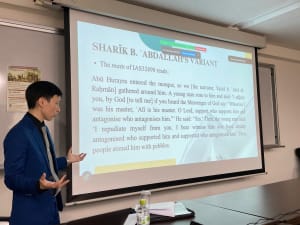Report
On December 4, 2024, the Institute for Advanced Studies on Asia (Tobunken) hosted a seminar titled “‘Who I was his master, ʿAlī is his master’: The Narrative Development of a Shīʿī Hadith and Its Transmitters in the Eighth Century,” with Professor I-Wen Su from National Chengchi University (Taipei) as the speaker.
Professor Su’s lecture examined the traditions attributed to the Prophet Muhammad that convey the message, “For whoever considers me his master, ʿAlī is his master,” focusing on variations in both the transmission chains and the content of these traditions. Identifying Kufa in the late 7th to 8th centuries as the starting point for the widespread dissemination of this body of traditions, Professor Su proposed an interpretation situating their early spread within the context of Kufan regionalism, which sought to elevate ʿAlī in opposition to the political assertions of the Umayyad dynasty.
During the Q&A session, participants raised constructive questions, including one regarding Professor Su’s distinction between this regionalism and Shīʿism, prompting further exploration of the lecture’s themes. The seminar was attended by approximately 10 participants in person and 30 online.
Event Details
Date and Time: Wednesday, December 4, 2024, 18:00–19:40
Venue: Conference Room No. 1, The Institute for Advanced Studies on Asia 3F, Hongo Campus, The University of Tokyo (東京大学東洋文化研究所3階、第一会議室), and online via Zoom.
Speaker: I-Wen Su (National Chengchi University)
Title: ‘Who I was his master, ʿAlī is his master’: The Narrative Development of a Shīʿī Hadith and Its Transmitters in the Eighth Century
Chair: Kazuo Morimoto (Professor in Islamic and Iranian History, Institute for Advanced Studies on Asia, University of Tokyo)
Abstract: This lecture addresses a Prophetic tradition, ‘Who I was his master, ʿAlī is his master’ (man kuntu mawlāhu fa-ʿAlī mawlāhu). This hadith is cited by Shīʿī and Sunnī Muslims alike to articulate ʿAlī’s exclusive legitimacy to rule or his privileged standing in the first Muslim community; however, its origins remain understudied. The lecturer will present the results of an analysis of this Prophetic hadith through the isnād-cum-matn method, which not only pinpoint the time of its circulation or creation, but also identify the key transmitters responsible for the circulation of its variants. The sectarian tendencies of the pivotal figures in the dissemination of this hadith as depicted in early Arabic biography also provide valuable insights which can help to navigate the ambiguous sectarian boundaries in early Islam.

